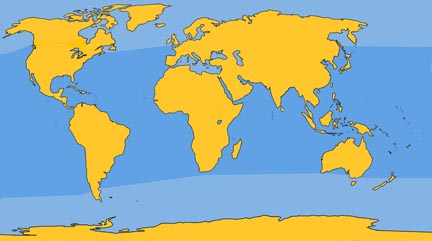 Family: Delphinidae
Family: Delphinidae
Genus: Globicephala
Species: G. macrorhynchus Gray, 1846
Taxonomic Note: The southern population is occasionally referred to as Globicephala scammoni, either an alleged species or subspecies. It possesses all of the characteristics of the short-finned pilot whale but has slightly larger flippers.
This animal’s domelike, bulbous head is similar to that of the long-finned pilot whale, as is its exaggerated vertical deepening of the keels at the caudal peduncle. It is distinguished, however, by its uniquely shaped flippers, which appear to be held rigid while the animal swims. As with several other cetacean species, males are larger than the females and have grosser features.
Physical Description: Stocky around the midsection, with a very elongated, deep peduncle. The large, rounded head has no beak and a slightly defined upper lip.
Color: They are jet black with a white anchor-shaped patch on the chin, extending down the ventral region to the anus. The anchor patch is usually not present in the variant form. There is often a white shading behind the dorsal fin.
Fins and Flukes: A large, well-defined falcate dorsal fin stretches back horizontally. It is rounded at the top and located farther to the front of the midback than that of any other cetacean. The small sickle-shaped flippers are well defined. The large, well-developed flukes are widely spread with a distinct median notch. The variant form possesses longer flippers.
Length and Weight: Males reach 19.5 ft (5.9 m) and an estimated 6,500 lb (3,000 kg); females have been recorded slightly exceeding 13 ft (4 m) and about 2,600 lb (1,200 kg).
Teeth: 7 to 9 large, conical teeth are found in each side of the upper and lower jaws. The variant form has 8 to 12 teeth on each side of the upper and lower jaws.
Feeding: Predominantly squid, but small fish are eaten occasionally.
Breathing and Diving: Short-finned pilot whales are capable of dives as deep as 2,000 ft (600 m).
Mating and Breeding: The breeding season is thought to be extended; the gestation period is believed to be 11 to 13 months. Calves, 4.5 ft (1.4 m) are born at 3-year intervals.
Herding: Groups of several hundred are common.
Distribution: Tropical and warm, temperate waters of the Atlantic, Pacific, and Indian Oceans.
Migration: There is a definite migration from cold to warm water, although little is understood.
Natural History Notes: They often may be seen “logging” on the surface remaining stationary, exposing the bulbous head and dorsal fin.








